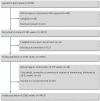A prospective cohort study investigating associations between hyperemesis gravidarum and cognitive, behavioural and emotional well-being in pregnancy
- PMID: 22125621
- PMCID: PMC3220681
- DOI: 10.1371/journal.pone.0027678
A prospective cohort study investigating associations between hyperemesis gravidarum and cognitive, behavioural and emotional well-being in pregnancy
Abstract
Objectives: To investigate the association between hyperemesis gravidarum and altered cognitive, behavioural and emotional well-being in pregnancy.
Methods: The study cohort consisted of 3423 nulliparous women recruited in the Screening for Pregnancy Endpoints (SCOPE) study performed in Auckland, New Zealand; Adelaide, Australia; Cork, Ireland; Manchester and London, United Kingdom between November 2004 and August 2008. Women were interviewed at 15±1 weeks' gestation and at 20±1weeks' gestation. Women with a diagnosis of hyperemesis gravidarum (HG) were compared with women who did not have a diagnosis of HG. Main outcome measures included the Short form State- Trait Anxiety Inventory (STAI) score (range 6-24), Perceived Stress Scale score (PSS, range 0-30), Edinburgh Postnatal Depression Scale (EPDS) score (range 0-30 or categories a-c) and behavioural responses to pregnancy score (limiting/resting [range 0-20] and all-or-nothing [range 0-28]).
Results: During the study period 164 women suffered from HG prior to their 15 week interview. Women with HG had significantly higher mean STAI, PSS, EPDS and limiting response to pregnancy scores compared to women without HG. These differences were observed at both 15±1 and 20±1 weeks' of gestation. The magnitude of these differences was greater in women with severe HG compared to all women with HG. Women with severe HG had an increased risk of having a spontaneous preterm birth compared with women without HG (adjusted OR 2.6 [95% C.I. 1.2, 5.7]).
Conclusion: This is the first large prospective study on women with HG. Women with HG, particularly severe HG, are at increased risk of cognitive, behavioural and emotional dysfunction in pregnancy. Women with severe HG had a higher rate of spontaneous preterm birth compared to women without HG. Further research is required to determine whether the provision of emotional support for women with HG is beneficial.
Conflict of interest statement
Similar articles
-
Previous pregnancy loss has an adverse impact on distress and behaviour in subsequent pregnancy.BJOG. 2015 Dec;122(13):1757-64. doi: 10.1111/1471-0528.13233. Epub 2015 Jan 6. BJOG. 2015. PMID: 25565431
-
Hyperemesis gravidarum and the risk of emotional distress during and after pregnancy.Arch Womens Ment Health. 2017 Dec;20(6):747-756. doi: 10.1007/s00737-017-0770-5. Epub 2017 Aug 25. Arch Womens Ment Health. 2017. PMID: 28842762 Free PMC article.
-
Norwegian PUQE (Pregnancy-Unique Quantification of Emesis and nausea) identifies patients with hyperemesis gravidarum and poor nutritional intake: a prospective cohort validation study.PLoS One. 2015 Apr 1;10(4):e0119962. doi: 10.1371/journal.pone.0119962. eCollection 2015. PLoS One. 2015. PMID: 25830549 Free PMC article.
-
Depression, anxiety, stress and hyperemesis gravidarum: temporal and case controlled correlates.PLoS One. 2014 Mar 17;9(3):e92036. doi: 10.1371/journal.pone.0092036. eCollection 2014. PLoS One. 2014. PMID: 24637791 Free PMC article.
-
Hyperemesis gravidarum and neonatal outcomes: A systematic review of observational studies.Taiwan J Obstet Gynecol. 2021 May;60(3):422-432. doi: 10.1016/j.tjog.2021.03.007. Taiwan J Obstet Gynecol. 2021. PMID: 33966723
Cited by
-
Women with prolonged nausea in pregnancy have increased risk for depressive symptoms postpartum.Sci Rep. 2018 Oct 25;8(1):15796. doi: 10.1038/s41598-018-33197-1. Sci Rep. 2018. PMID: 30361517 Free PMC article.
-
A Systematic Review and Meta-Analysis of the Utility of Corticosteroids in the Treatment of Hyperemesis Gravidarum.Nutr Metab Insights. 2016 Feb 4;8(Suppl 1):23-32. doi: 10.4137/NMI.S29532. eCollection 2015. Nutr Metab Insights. 2016. PMID: 26877629 Free PMC article. Review.
-
Suicidal ideation and associated factors among pregnant women attending antenatal care at public hospitals of Harari regional state, eastern Ethiopia: A cross-sectional study.PLoS One. 2024 Mar 28;19(3):e0300417. doi: 10.1371/journal.pone.0300417. eCollection 2024. PLoS One. 2024. PMID: 38547179 Free PMC article.
-
Well-being in high-risk pregnancy: an integrative review.BMC Pregnancy Childbirth. 2020 Sep 11;20(1):526. doi: 10.1186/s12884-020-03190-6. BMC Pregnancy Childbirth. 2020. PMID: 32912254 Free PMC article. Review.
-
The Pregnancy-Unique Quantification of Emesis and Nausea (PUQE-24): Configural, Measurement, and Structural Invariance between Nulliparas and Multiparas and across Two Measurement Time Points.Healthcare (Basel). 2021 Nov 15;9(11):1553. doi: 10.3390/healthcare9111553. Healthcare (Basel). 2021. PMID: 34828598 Free PMC article.
References
-
- Gazmararian JA, Petersen R, Jamieson DJ, Schild L, Adams MM, et al. Hospitalizations during pregnancy among managed care enrollees. Obstet Gynecol. 2002;100:94–100. - PubMed
-
- Tierson FD, Olsen CL, Hook EB. Nausea and vomiting of pregnancy and association with pregnancy outcome. Am J Obstet Gynecol. 1986;155:1017–1022. - PubMed
-
- Organisation WH International Statistical Classification of Diseases and Related Health Problems. 10th Revision. Version for 2007.
-
- Hod M, Orvieto R, Kaplan B, Friedman S, Ovadia J. Hyperemesis gravidarum. A review. J Reprod Med. 1994;39:605–612. - PubMed
Publication types
MeSH terms
LinkOut - more resources
Full Text Sources
Medical


